When I usually think of cutthroat trout — no matter where I go to catch them, from northern New Mexico to southern British Columbia — I think of elegant wild trout that are quick to rise to dry flies. Given where they live, and the fish with which they often share habitat, I seldom think of cutthroats as fish that, well, eat other fish.
And that’s a mistake.
Native cutthroats from the Rio Grande north to the Elk River do, indeed, munch on big bites of fishy protein, and they are, in my experience, more tuned in to chasing other fish when water is high and a little murky, particularly in the spring and early summer as runoff begins to wane.
In recent years, on a local trout stream that gets a sizable spawning run of native Snake River fine-spotted cutthroats from an area reservoir, I’ve taken to throwing big articulated streamers that get down deep and move water. These big flies, normally tied for fish most of us would assume to be more predatorial — browns, rainbows and even big char, like bull trout — seem to pull the biggest cutthroats in the creek out from under logjams and overhanging banks. And when these big fish hit, they really hit — it’s not the tentative, somewhat lazy, cutthroat “sip” that occurs later in the summer as the water clears.
For a lot of fishy folks, it’s no epiphany that cutthroats will chase and eat other fish. In Utah, for example, when it came time to try and eliminate the “rough” fish from the fabled Strawberry Reservoir some 30 years ago, state fisheries managers didn’t turn to exotic brown trout or Lake Michigan lake trout. They planted non-native Bonneville cutthroat trout from Bear Lake that straddles the border of Utah and Idaho (yes, the native Colorado River cutthroat trout might have been a better choice for Strawberry, but the chubs and suckers the reservoir were so prolific that a predator accustomed to eating other fish was needed). Bear Lake’s native cutthroats are fish eaters in a big way, existing largely on a diet of cisco, a large, schooling relative of the whitefish.
On the South Fork of the Snake River here in Idaho, a streamer on the swing is just as likely to entice a 20-inch cutthroat as it is a 20-inch brown — the river is so prolific when it comes to aquatic life, that the native fish have their pick from young whitefish and even young rainbows and brown trout. And, yes, they’ll even ingest their own young.
The dry-fly reputation often applied to cutthroats is well-earned. That reputation is likely why the South Fork is such a famous river for anglers who love to cast big dry flies. But, just four years ago, an angler on the South Fork caught on a streamer a native Yellowstone cutthroat that likely weighed close to 8 pounds and, had the angler measured it, it could have very well stretched the tape to 30 inches (she released the fish after snapping a few photos, as is required Idaho regulations). If you think a fish like that got to be so big by sipping PMDs off the surface, you’re sadly mistaken.
Think too, about the Lahontan cutthroat trout fishery in Nevada. Historically, the native cutthroats migrated from Pyramid Lake all the way up the slope of the eastern Sierra, where they spawned in Lake Tahoe. While that migration is now likely impossible, thanks to irrigation diversions and fish barriers, the big fish are being restored to Pyramid Lake, and anglers are catching more and more trophy trout. And, for the most part, those big natives aren’t eating insects. They, like their cutthroat cousins all across the West, are fish eaters.
On my local cutthroat stream, I enjoy the cutthroats that spend most of the year in a large reservoir, but start to run up tributary streams in April and May. In some of the tributaries, the fish will spawn under the cover of high water, but in a couple of creeks that are more productive from the food perspective, the “lake fish” will hang out all summer and enjoy the high-country largesse that ranges from prolific Green Drake hatches in June to grasshopper and terrestrial hatches that last into September. It helps, too, I think, that this particular creek is also home to a big run of native Utah suckers — these fish school up and swim upstream like salmon, where they load the creek with eggs in the spring, and then with fry and fingerlings as the eggs hatch in early summer.
But the cutthroats spawn there, too, and they’ll go after their own young. In fact, perhaps my favorite streamer to cast when the water is coming down from its peak at high runoff, is an orange and yellow Slumpbuster, weighted with barbell eyes to get it down in fast water. On a recent outing, this “cutthroat fly” helped me bring several cutthroats to hand between 16 and 20 inches in a fairly unassuming high-mountain stream that most folks might associate more with non-native brook trout or small, wild cutthroats that hit dry flies with abandon (thankfully, brookies never found their way into this stream, and there are lots of small cutthroats, but they tend to stick to the skinny upper reaches of the stream until, like their parents, they migrate to the lake).
While the dry-fly-eating habits of cutthroat trout have garnered appreciation for the fish across their native range, it’s a mistake to think that cutthroats are somehow less inclined to chase big streamers than their non-native competitors. Like any trout, they subscribe to a varied and opportunistic diet. In the Bear River of southern Idaho, native Bonneville cutthroat trout have been caught and dissected. Their stomach contents, just as often as not? Baby carp.
The lesson? When the protein is there, cutthroats will eat it. Don’t assume that these beautiful native trout are so pure that they’ll only eat mayfly duns and that the only way to chase them is with the associated imitations cast upstream.
The fish that might eat a size 16 Adams in July likely spent the month of June chasing and eating baby suckers … or even baby cutthroats.




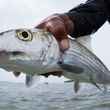
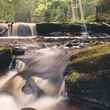









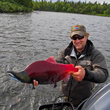
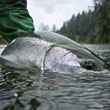








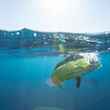
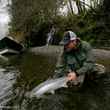

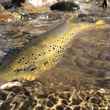

Comments
doug balfour replied on Permalink
Chris, I caught an 18 inch cutt during the Salmon Fly hatch a few years ago. South Fork. He took a Salmon Fly imitation. When I netted him he had the tail of about a six inch cutty still sticking out of his mouth. He still could not resist a Salmon Fly.
Kevin replied on Permalink
The strongest and longest fighting trout I had so far this year was a cutthroat trout that hit a Sex Dungeon streamer on the Dream Stream in Colorado in late April. It jumped once then would take line every time I thought I had the upper hand. Great fight on a 7 wt and I was surprised it was a cutthroat trout when I got it to the net.
Pages